Nicholas Hawksmoor was an English architect. He was a leading figure of the English Baroque style of architecture in the late-seventeenth and early-eighteenth centuries. Hawksmoor worked alongside the principal architects of the time, Christopher Wren and John Vanbrugh, and contributed to the design of some of the most notable buildings of the period, including St Paul's Cathedral, Wren's City of London churches, Greenwich Hospital, Blenheim Palace and Castle Howard. Part of his work has been correctly attributed to him only relatively recently, and his influence has reached several poets and authors of the twentieth century.

Castle Howard is a stately home in North Yorkshire, England, within the civil parish of Henderskelfe, located 15 miles (24 km) north of York. It is a private residence and has been the home of the Carlisle branch of the Howard family for more than 300 years. Castle Howard is not a fortified structure, but the term "castle" is sometimes used in the name of an English country house that was built on the site of a former castle.
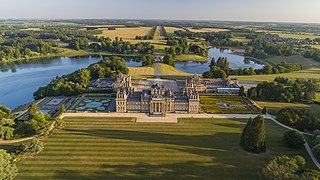
Blenheim Palace is a country house in Woodstock, Oxfordshire, England. It is the seat of the Dukes of Marlborough and the only non-royal, non-episcopal country house in England to hold the title of palace. The palace, one of England's largest houses, was built between 1705 and 1722, and designated a UNESCO World Heritage Site in 1987.

Ripon is a cathedral city in the Borough of Harrogate, North Yorkshire, England. The city is located at the confluence of two tributaries of the River Ure, the Laver and Skell. Historically part of the West Riding of Yorkshire, the city is noted for its main feature, Ripon Cathedral, which is architecturally significant, as well as the Ripon Racecourse and other features such as its market.
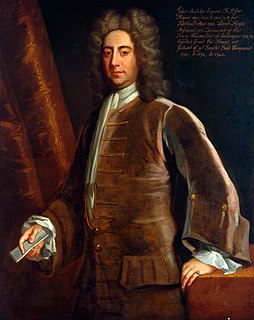
John Aislabie or Aslabie, of Studley Royal, near Ripon, Yorkshire, was a British politician who sat in the English and British House of Commons from 1695 to 1721. He was of an independent mind, and did not stick regularly to the main parties. He was Chancellor of the Exchequer at the time of the South Sea Bubble and his involvement with the Company led to his resignation and disgrace.
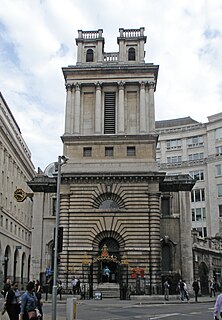
St Mary Woolnoth is an Anglican church in the City of London, located on the corner of Lombard Street and King William Street near Bank junction. The present building is one of the Queen Anne Churches, designed by Nicholas Hawksmoor. The parish church continues to be actively used for services, with Holy Communion every Tuesday. St Mary Woolnoth lies in the ward of Langbourn.

Studley Royal Park including the ruins of Fountains Abbey is a designated World Heritage Site in North Yorkshire, England. The site, which has an area of 323 hectares features an 18th-century landscaped garden, some of the largest Cistercian ruins in Europe, ruins of a Jacobean mansion and a Victorian church designed by William Burges. It was developed around the house, destroyed in a fire in 1946, and eventually came to include the ruins of the Cistercian Fountains Abbey.

Undercliffe Cemetery is located between Otley Road and Undercliffe Lane in the Bolton and Undercliffe ward, Bradford, West Yorkshire, England. The cemetery stands atop a hillside overlooking the city and contains some very impressive Victorian funerary monuments in a variety of styles. It is a notable example of a Victorian cemetery where a number of rich and prominent local residents have been buried, notably mill owners and former mayors. Undercliffe Cemetery is grade II* listed by English Heritage in their Register of Parks and Gardens of Special Historic Interest in England.

Kirkby Fleetham is a village in the Hambleton District of North Yorkshire, England about 1 mile (1.6 km) east of the A1(M) road. Along with the two nearby villages of Great Fencote and Little Fencote it forms the civil parish of Kirkby Fleetham and Fencote. At the 2011 census, it was recorded as having a population of 560.
William Benson was a talented amateur architect and Whig politician who sat in the House of Commons from 1715 to 1719. In 1718, he arranged to displace the aged Sir Christopher Wren as Surveyor of the King's Works, a project in which he had the assistance of John Aislabie, according to Nicholas Hawksmoor, who was deprived of his double post to provide places for Benson's brother.
William Aislabie was a British governor of the Bombay Presidency during the days of the East India Company.

William Aislabie of Studley Royal, North Yorkshire was an English landowner and Tory politician who sat in the House of Commons for over 60 years from 1721 to 1781. His long unbroken service in the House of Commons was only surpassed, more than 100 years after his death, by the 63 years achieved by Charles Pelham Villiers at Wolverhampton.
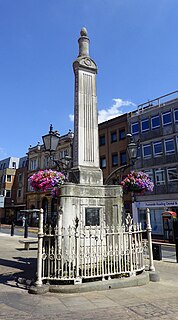
The Simeon Monument, also known as the Soane Obelisk, the Soane Monument and the Simeon Obelisk, is a stone structure in Market Place, the former site of the market in Reading, Berkshire. It was commissioned by Edward Simeon, a Reading-born merchant who became extremely wealthy as a City of London trader. Edward Simeon's brother John Simeon was a former Member of Parliament for Reading who had lost his seat in the 1802 elections to the parliament of the newly created United Kingdom of Great Britain and Ireland, since which time the family had been engaged in ostentatious spending locally in an effort to gain support among the town's voters. Although street lighting had been installed in Reading in 1797, the system used was one of lamps attached to the sides of buildings and as a consequence open spaces remained unlit. In 1804 Simeon persuaded the Mayor of Reading that it would be of benefit to erect a structure in Market Place, which would serve both to carry lamps to light the area and to improve the flow of traffic in the area, and volunteered to pay for such a structure himself.

Northampton War Memorial, officially the Town and County War Memorial, is a First World War memorial on Wood Hill in the centre of Northampton, the county town of Northamptonshire, in central England. Designed by architect Sir Edwin Lutyens, it is a Stone of Remembrance flanked by twin obelisks draped with painted stone flags standing in a small garden in what was once part of the churchyard of All Saints' Church.
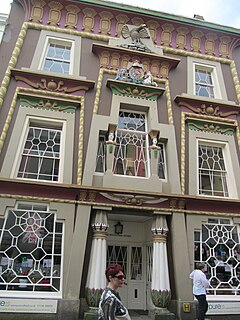
Egyptian Revival architecture in the British Isles is a survey of motifs derived from Ancient Egyptian sources occurring as an architectural style. Egyptian Revival architecture is comparatively rare in the British Isles. Obelisks start appearing in the 17th century, mainly as decorative features on buildings and by the 18th century they started to be used in some numbers as funerary or commemorative monuments. In the later 18th century, mausoleums started to be built based on pyramids, and sphinxes were used as decorative features associated with monuments or mounted on gate piers. The pylon, a doorway feature with spreading jambs which support a lintel, also started to be used and became popular with architects.
William Lawrence or Laurence was a British politician who sat in the House of Commons on three occasions between 1761 and 1798.
Sir William Rawlinson (1640–1703) was an English serjeant-at-law and Commissioner for the Great Seal of the Realm between 1688 and 1693.
William Aislabie, of Ditton, Surrey, was a British politician who sat in the House of Commons from 1727 to 1734.

Hack Fall Wood, otherwise known as Hackfall, is a Site of Special Scientific Interest, or SSSI, of 44.8687 hectares, lying north-east of the village of Grewelthorpe, North Yorkshire, England. During the 18th century it was landscaped in the picturesque style by landowner William Aislabie, who created views by engineering streams and pools, planting trees and building follies. Turner and Gilpin painted it, and pictures of it featured on Catherine the Great's 1773 Wedgwood dinner service. Some 19th century writers called it "one of the most beautiful woods in the country."

Ripon Town Hall is a municipal building in the Market Place, Ripon, North Yorkshire, England. The structure, which was the headquarters of Ripon Borough Council, is a Grade II* listed building.














